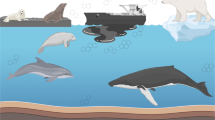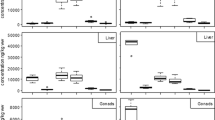Abstract
Transportation of crude oil across North America’s boreal ecozone creates the potential for spills in freshwater where less is known about the sensitivity of resident fish than for marine systems. The sensitivity of wild fathead minnows (FHM) to residual concentrations (ppb range) of the water accommodated fraction (WAF) of diluted bitumen (dilbit) was assessed by exposing them for 21 days followed by a 14 days depuration. Target concentrations were well below detection limits for GC–MS, but were estimated by dilution factor (1:100,000 and 1:1,000,000 WAF:water) to contain less than 0.0003 μg/L of polycyclic aromatic compounds. Confinement and handling stress caused by transfer of wild fish into tanks much smaller than their natural range resulted in mortality and lower body condition among all groups, but interactive effects of oil exposures still resulted in females with smaller cortical alveolar oocytes, and males with larger testicular lobe lumen sizes. Additional studies examining the compounded effects of stress and environmentally relevant oil exposures in wild fishes are needed.





Similar content being viewed by others
References
Adams J, Bornstein JM, Munno K et al (2014) Identification of compounds in heavy fuel oil that are chronically toxic to rainbow trout embryos by effects-driven chemical fractionation. Environ Toxicol Chem 33:825–835
Agostinis A, Dal Pont G, Horodesky A et al (2017a) Is there detectable long-term depletion of genetic variation in freshwater fish species affected by an oil spill? Water Air Soil Pollut 228:256
Alsaadi F, Hodson PV, Langlois VS (2018a) An embryonic field of study: the aquatic fate and toxicity of diluted bitumen. Bull Environ Contam Toxicol 100:8–13
Alsaadi FM, Madison BN, Brown RS et al (2018b) Morphological and molecular effects of two diluted bitumens on developing fathead minnow (Pimephales promelas). Aquat Toxicol 204:107–116
Ankley GT, Grim C, Duffell S et al (2006) Histopathology guidelines for the Fathead minnow (Pimephales promelas) 21-day reproduction assay. USEPA, 59 p
Ankley GT, Bennett RS, Erickson RJ et al (2010) Adverse outcome pathways: a conceptual framework to support ecotoxicology research and risk assessment. Environ Toxicol Chem 29:730–741
Bustin SA, Benes V, Garson JA et al (2009) The MIQE guidelines: minimum information for publication of quantitative real-time PCR experiments. Clin Chem 55:611–622
Carls MG, Holland L, Larsen M et al (2008) Fish embryos are damaged by dissolved PAHs, not oil particles. Aquat Toxicol 88:121–127
CEPA (2015) CEPA initiative: response time guideline. CEPA, Calgary, AB
Crosby S, Fay R, Groark C, et al (2013) Transporting Alberta oil sands products: defining the issues and assessing the risks. Department of Commerce, National Oceanic and Atmospheric Administration, National Ocean Service, Office of Response and Restoration, Seattle, WA
Divino JN, Tonn WM (2008) Importance of nest and paternal characteristics for hatching success in Fathead minnow. Copeia 4:920–930
Everaarts JM, Shugart LR, Gustin MK et al (1993) Biological markers in fish: DNA integrity, hematological parameters and liver somatic index. Mar Environ Res 35:101–107
Huuskonen S, Lindström-Seppä P (1995) Hepatic cytochrome P4501A and other biotransformation activities in perch (Perca fluviatilis): the effects of unbleached pulp mill effluents. Aquat Toxicol 31:27–41
Kavanagh RJ, Frank RA, Oakes KD et al (2011) Fathead minnow (Pimephales promelas) reproduction is impaired in aged oil sands process-affected waters. Aquat Toxicol 101:214–220
Kavanagh RJ, Frank RA, Burnison BK et al (2012) Fathead minnow (Pimephales promelas) reproduction is impaired when exposed to a naphthenic acid extract. Aquat Toxicol 116–117:34–42
Leatherland JF, Sonstegard RA (1984) Pathobiological responses of feral teleosts to environmental stressors: interlake studies of the physiology of Great Lakes salmon. In: Carins VM, Hodson PV, Nriagu JO (eds) Contaminant effects on fisheries. Wiley, New York, pp 115–150
Madison BN, Hodson PV, Langlois VS (2017) Cold Lake Blend diluted bitumen toxicity to the early development of Japanese medaka. Environ Pollut 225:579–586
Mager EM, Pasparakis C, Stieglitz JD et al (2018) Combined effects of hypoxia or elevated temperature and Deepwater Horizon crude oil exposure on juvenile mahi-mahi swimming performance. Mar Environ Res 139:129–135
Martyniuk CJ, Denslow ND (2012) Exploring androgen-regulated pathways in teleost fish using transcriptomics and proteomics. Integr Comp Biol 52:695–704
McDonnell D, Madison BN, Baillon L et al (2019) Comparative toxicity of two diluted bitumens to developing yellow perch (Perca flavescens). Sci Total Environ 655:977–985
McKim JM (1977) Evaluation of tests with early life stages of fish for predicting long-term toxicity. J Fish Res Board Can 34:1148–1154
Nash RDM, Valencia AH, Geffen AJ (2006) The origin of Fulton’s condition factor—setting the record straight. Fisheries 31:236–238
Natural Resources Canada (2017) Energy fact book 2016–2017. Natural Resources Canada, Ottawa
Noskov YA, Nikulina YS, Romanov RE et al (2018) Hydrobionts of a freshwater oil-polluted northern lake: bioaccumulation of heavy metals in fish and the rate of ecosystem recovery Noskov. Ukr J Ecol 8:383–391
Palace VP, Evans RE, Wautier K et al (2002) Induction of vitellogenin and histological effects in wild fathead minnows from a lake experimentally treated with the synthetic estrogen, ethynylestradiol. Water Qual Res J Can 37:637–650
Pankhurst NW (2016) Reproduction and development. In: Schreck CB, Tort L, Farrell A, Brauner C (eds) Biology of stress in fish, 1st edn. Elsevier Inc., Amsterdam, pp 295–331
Parrott JL, Raine JC, McMaster ME, Hewitt LM (2019) Chronic toxicity of oil sands tailings pond sediments to early life stages of fathead minnow (Pimephales promelas). Heliyon 5:e02509
Playle RC (1987) Chemical effects of spring and summer alum additions to a small, Northwestern Ontario Lake. Water Air Soil Pollut 34:207–225
Raine JC, Pietrock M, Willner K et al (2017) Parasitological analysis and gill histopathology of Pearl Dace (Semotilus Margarita) and Brook Stickleback (Culaea Inconstans) collected from the Athabasca oil sands area (Canada). Bull Environ Contam Toxicol 98:733–739
RStudio Team (2019) RStudio: integrated development for R. RStudio, PBC, Boston, MA. http://www.rstudio.com/
Stoyanovich SS, Yang Z, Hanson M et al (2019) Simulating a spill of diluted bitumen: environmental weathering and submergence in a model freshwater system. Environ Toxicol Chem 38:2621–2628
Tetreault GR, McMaster ME, Dixon DG, Parrott JL (2003) Using reproductive endpoints in small forage fish species to evaluate the effects of Athabasca Oil Sands activities. Environ Toxicol Chem 22:2775–2782
Unger LM, Sargent RC (1988) Allopaternal care in the fathead minnow, Pimephales promelas: females prefer males with eggs. Behav Ecol Sociobiol 23:27–32
USEPA (1996) Method 3510C: Separatory Funnel Liquid-Liquid Extraction. 8
USEPA (2002) A short-term method for assessing the reproductive and devel- opmental toxicity of endocrine-disrupting chemicals using the fathead minnow (Pimephales promelas). USEPA, Cincinnati, OH
USEPA (2018) Method 8270E: semivolatile organic compounds by GC/MS. USEPA Test Methods 64
Van den Heuvel MR, Hogan NS, Roloson SD, Van Der Kraak GJ (2012) Reproductive development of yellow perch (Perca flavescens) exposed to oil sands-affected waters. Environ Toxicol Chem 31:654–662
Wendelaar Bonga SE (1997) The stress response in fish. Physiol Rev 77:591–625
Acknowledgements
Funding for this study was provided by an NSERC grant (STPGP 493786-16) awarded to J. Blais, M. Hanson and D. Orihel and also by the National Contaminants Advisory Group (NCAG) of the DFO to VSL and VPP. Preparation of WAF at NRCan was funded by the Government of Canada Oceans Protection Plan. Funding was also provided by the IISD-ELA Graduate Fellowship and the Manitoba Graduate Scholarship, both awarded to LT. VSL holds a Canada Research Chair in Ecotoxicogenomics and Endocrine Disruption. Particular thanks to C. Rodgers, J. Neall, K. Friesen, L. Hayhurst, L. Hrenchuk, P. Bulloch, and S. Michaleski for their assistance in construction of the experimental set up, caring for the minnows, and completing dissections.
Author information
Authors and Affiliations
Contributions
All authors contributed to the execution of the study. Study conception and design were led by VP. Material preparation, data collection and the majority of analyses were completed by LT. Additional analyses were completed by LEP, SJW, HD and JM. Laboratory space, equipment and consumables for analysis were provided by RSB and VSL. The first draft of this manuscript was written by LT. All authors read and approved the final manuscript.
Corresponding author
Ethics declarations
Conflict of interest
The authors declare they have no potential conflicts of interest affecting the integrity of this work.
Research Involving Animal Rights
Study design and care regime for animals was approved under University of Manitoba Animal User Protocol #F17-010.
Additional information
Publisher's Note
Springer Nature remains neutral with regard to jurisdictional claims in published maps and institutional affiliations.
Rights and permissions
About this article
Cite this article
Timlick, L., Peters, L.E., Wallace, S.J. et al. Effects of Environmentally Relevant Residual Levels of Diluted Bitumen on Wild Fathead Minnows (Pimephales promelas). Bull Environ Contam Toxicol 105, 699–704 (2020). https://doi.org/10.1007/s00128-020-03008-3
Received:
Accepted:
Published:
Issue Date:
DOI: https://doi.org/10.1007/s00128-020-03008-3




